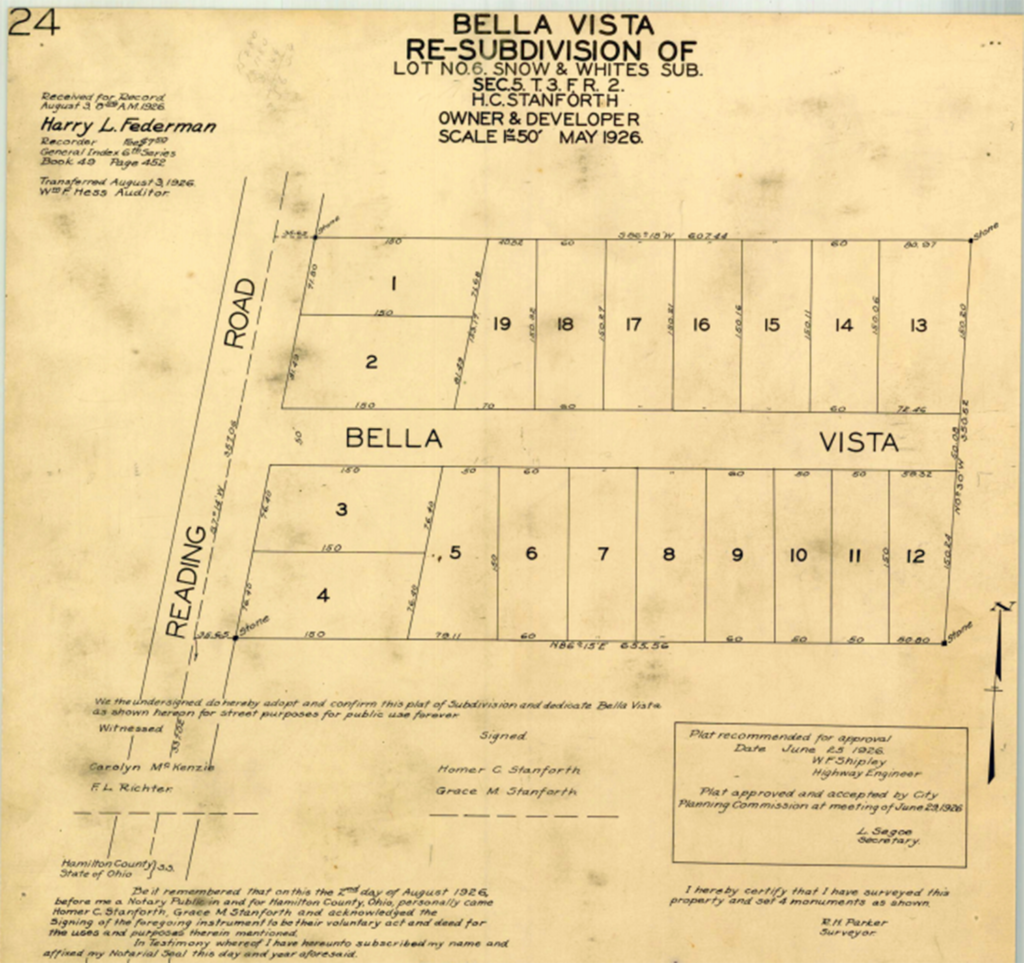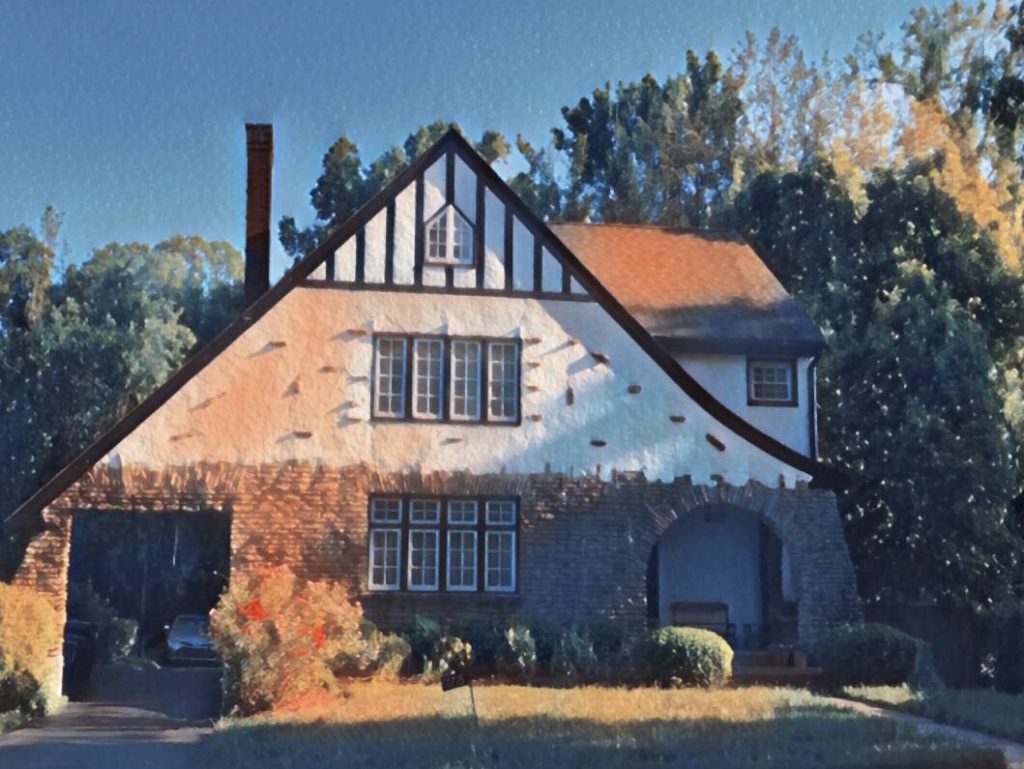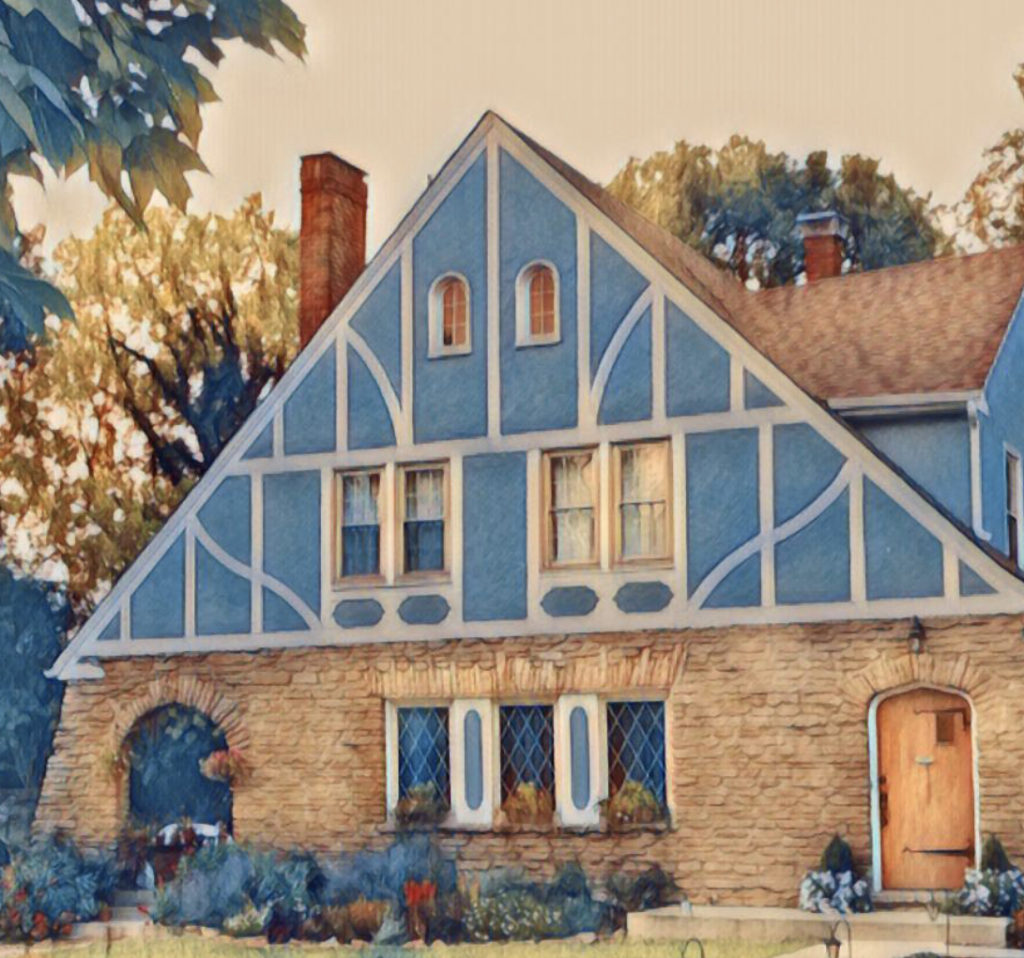by Alexis Liu
Originally published on HistoricBellaVista.com
In 1926, Cincinnati developer Arthur R. Green began the development of an enclave of Tudor Revival homes across Reading Road from the Maketewah Country Club, in the neighborhood of Bond Hill. Acquiring the plot from the Snow & White subdivision, Green first advertised the new neighborhood as “Belle Vista.” Green’s promise to buyers was elegant living in a “restricted neighborhood” that offered protection from the threats of Jazz Age overdevelopment.

Green’s project, quickly renamed “Bella Vista,” showed early promise, with the building of several attractive model homes in mock English cottage style. Competition from other builders, however, was intense. Though Bond Hill had been founded in the 1870s by a cooperative community, beyond the streets of Old Bond Hill, much of the land remained given over to farmland and orchards until the 1920s. Now, just as Green’s project was coming to market, the last of Bond Hill’s agrarian estates were being carved up, divided and subdivided. New streets were advertised everywhere — Andina, Avonlea, Laconia, Elizabeth — and Bella Vista.
A few homes, such as 1718 Bella Vista, sold quickly but others languished on the market. By 1929, liens were issued against the unsold houses and, eventually, all the remaining lots and houses were foreclosed upon. Certain homes, such as 1722 Bella Vista, were ordered sold on the courthouse steps. Undeveloped lots were turned over to other developers and builders, like 1743 Bella Vista, which was eventually built by the H.C. Stanforth Co.
Despite the crippling blow of the Great Depression, by 1936, a number of agents, builders and developers would finish what Green had begun by building all 17 homes that comprise Bella Vista today. Still, it is Green’s vision of a quaint country-style lane dotted by modestly sized homes and lit by lamp light, that persists.

The largest building on the street, 1702 Bella Vista/5108 Reading Road is an elegant 4,300 square foot duplex designed by architect J.C. Grukenmeyer, partner in the firm Sullivan & Grukenmeyer, to whom Maketewah Country Club is attributed. Built in 1927, the earliest recorded resident was John A. Herschede, retired partner in Herschede Jewelers.
The same building was, at various times, also home to noted and controversial criminal defense attorney Louis B. Sawyer, professor Ralph B. Alspaugh and his wife, the writer and frequent lecturer Mrs. Lilyan Mae Haas Alspaugh, as well as Abraham Bruson, proprietor of the Bruson Motor Car Co. on Gilbert Avenue.

1714 Bella Vista Street was built in 1927, likely by Arthur R. Green. The home is notable on the street for its distinctive and apparently original striped awnings. The first owners were Joseph and Mary Kornmann. Evidently prosperous, Mr. Kornmann worked in the printing industry, and the family employed a live-in maid, who was noted in the 1930 Census. Live-in household seems to have been a relative rarity on the street. Later owners of the home included two doctors and at least one nurse who served in The Red Cross during World War II.

1715 Bella Vista was built in 1928 by developer Arthur R. Green. The graceful English-style cottage remained on the market for years, despite a stream of open houses and advertisements in The Cincinnati Enquirer. The property was foreclosed upon and in 1932 Sheriff Asa V. Butterfield ordered the home sold at auction. The Cline Mortgage Company acquired the property and finally sold the house to Fred B. Schrader in 1933, five years after it was erected.

Built by Arthur R. Green in 1927, 1718 Bella Vista Street was originally owned by William F. Orth and Mary Orth. The 3-bedroom plus nursery home was described in newspaper ads of the day as having extensive landscaping. The house was valued at $16,500 in the 1930 Census ($249,415.78 in 2018 dollars).
Unusually for the street that has seen relatively little turnover, the home has had no fewer than five owners during its 91 years, among them Charles R. Ibold of the Ibold cigar-manufacturing family and Rev. Robert J. Grosch. Rev. Grosch was pastor of Immanuel Lutheran Church in Avondale and at one time the chairman of the Cincinnati NAACP political action committee.
The house was stabilized and rehabilitated by the Homesteading and Urban Redevelopment Corporation (HURC) in 2015-2016, a subsidiary of The Port.

Originally owned by John and Ella Schreckenhofer, 1719 Bella Vista was built in 1931. Though the builder is unknown, the Schreckenhofers acquired the land to build from Ralph H. Prinz. Little is known about the original owners, who sold the home in 1939. The home was then owned by two generations of the Josefovsky family, who painted the exterior in a striking chartreuse trim.

1722 Bella Vista Street was built in 1927, by Arthur R. Green. The charming home failed to find a buyer immediately and was eventually ordered sold by Sheriff Asa V. Butterfield in 1931. The home has had two owners in its history.

Built in 1928, 1723 Bella Vista was first owned by Charles E. Smith and Sylvia Smith. Mr. Smith was an avid gardener and a manager in the printing and lithography business. Mr. Smith was born amidst the conflagration of the Great Chicago Fire of 1871 and moved to Ohio as a child, settling in Cincinnati as an adult. Mrs. Smith died in 1934. Charles Smith continued to live at 1723 Bella Vista until his death at age 92.

Built by Arthur R. Green in 1927, 1726 Bella Vista was the family home of Arthur and Edna Green, along with their sons Arthur Jr. and Robert, for 10 years. During this time, the home was frequently advertised for sale in the Cincinnati Enquirer, so it is unclear if this was intended to be a permanent residence, or if the Greens resided there out of necessity. One son, Robert S. Green, would go on to be a noted heart surgeon. The other son, Arthur R. Green, Jr., would go on to serve in World War II. Mrs. Edna Green died in 1956. Arthur Green died in 1970.

1727 Bella Vista was built by Holscher & Rape in 1932. The home’s first owner was Mr. John E. Lietemeyer, the junior owner of the eponymous of the John E. Lietemeyer & Son Funeral Home Co.

1730 Bella Vista was built in 1935. The first owners were Leon and Stella Loewenstine, who acquired the land from Oakley Coal & Supply Co. owner Adolph G. Cramer. Mr. Loewenstine was a tax examiner.

1731 Bella Vista was one of two homes on the street built as two-family residences. The home was built in 1932 for John and Lillie Vetter, who immediately began to advertise in the Cincinnati Enquirer for a single lodger, “Gentleman Preferred.”

A truly unique home, 1734 Bella Vista was erected in 1936 by owner-builder-architect Gustave M. Goldsmith of the Goldsmith Metal Lath Co, which was founded by his father Max S. Goldsmith. As recorded in The Memoirs of The Miami Valley, Vol. III, Mr. Goldsmith was was a graduate of Cornell University, and president of The Mosler Safe Company prior to joining his family firm.
He resided at 1734 Bella Vista with his wife, Alma Meyer Goldsmith, daughter Dorothy and son Gustave, Jr. The home was built to demonstrate The Goldsmith System, a proprietary quick building method employing fireproof materials and resilient architecture, “as safe as a modern skyscraper,” according to an advertisement in The Cincinnati Enquirer. The all-stucco exterior is perhaps best characterized as Mediterranean Revival. Mr. Goldsmith died in 1944. His son, Gustave M. Goldsmith, Jr. continued to reside in 1734 Bella Vista and offered structural engineering services from his home-based office.

Built in 1935 by the E.M. Costello & Son Building Co. for Dr. Arthur R. Theobald and Mrs. Irma G. Theobald, 1735 Bella Vista is the only Colonial Revival on the street. It also sustained the only documented fire on Bella Vista, being struck by an attic fire, just one week prior to its occupancy date.
The blaze sent Fire Lieutenant Howard Brown plunging to the ground, and he suffered fractured bones and internal injuries. It also resulted in $300 in damage to the $10,000 Colonial Revival home ($5,537.63 damage to a home value of $184,587.59, in 2018 dollars).
Dr. Theobald was director of The Avondale Animal Hospital and also a Bond Hill commercial landlord. The Theobalds lived in the home until 1957.

The only Georgian Revival home on the street, 1740 Bella Vista was built in 1936. The home commissioned by Joseph and Mina C. Sagmeister for her widowed mother, Mrs. Louise Colnot. The Sagmeisters lived at 166 Elizabeth Place, just a block away. Joseph Sagmeister, an attorney, also enjoyed a friendship with Louis B. Sawyer, the lawyer who occupied 1702 Bella Vista Street.

Built in 1936 by The James P. Mulford Co., 1739 Bella Vista is the only Norman Revival home on the street. Though entirely harmonious with the English cottage style which predominates on the street, the house is nonetheless a distinctly different turreted ode to a French battlement. Eschewing the stucco seen on most of the houses, the facade is entirely dark brown brickwork and the entry door is crowned with a graven stone coat of arms.

Erected in 1936, 1743 Bella Vista was custom built for Harry Russell Jones and Bess Buehler Jones. Mr. Jones was a World War I veteran and an insurance adjuster at Western Adjustment & Inspection. Mrs. Buehler Jones was active in women’s Republican political clubs.

Built for Albert and Pauline Widmann in 1927, 5026 Reading Road does not have a Bella Vista address but does open onto the street and contributes the interesting and charming character of the street. Mr. Widmann was a Vice President of Western Bank and Trust Company, having worked his way to the position over 50 years of service, begun as a teenage courier for the bank.
The 2,799 square foot home would later be owned by Dr. Anthony Pascal, a native of Greece.

The 1930 Census provides a first look at the handful of families who then called Bella Vista Avenue home. At the time this was a street populated predominantly by middle class second generation European immigrants. With the notable exception of John A. Herschede, who hailed from the Herschede jewelry family, the male heads of household were generally middle rank managers or entrepreneurs. Prior to World War II, the women remained at home to raise children and tended house. Their families were from Germany, Ireland, and Poland. They were Protestant, Catholic and Jewish. Most were decidedly middle class but there was at least one live-on-premise servant.
Over the intervening decades, Bella Vista would be home to doctors, dentists, lawyers, nurses, nuns, ministers, an architect, and an engineer. As was typical of Bond Hill generally, the first African American homeowners moved onto the street in the 1960’s, integrating Bella Vista in its fourth decade.
Notable past residents include:
- Ohio State University Professor Ralph B. Alspaugh and his wife Lilyan Mae Haas Alspaugh, author and frequent lecturer
- Louis B. Sawyer, Esq., noted criminal defense attorney
- Abraham Bruson, proprietor of the Bruson Motor Car Company on Gilbert Avenue Residents of 1726 Bond Hill Bella Vista
- Arthur R. Green, developer of 14 lots on Bond Hill Bella Vista and homes throughout Cincinnati
- Robert Green, noted pioneering heart surgeon
- Herbert Tiemeyer, trumpeter for the Cincinnati Symphony Orchestra for over 40 years. He gave lessons out of his Bella Vista home. (H/T to Andy Glas for this information; thank you!)
- John E. Lietemeyer, the junior owner of the eponymous of the John E. Lietemeyer & Son Funeral Home Company
- Gustave M. Goldsmith, Sr. the owner-builder-architect of 1734 Bella Vista and President of the Goldsmith Metal Lath Company
- Gustave M. Goldsmith, Jr., structural engineer
- Dr. Arthur R. Theobald, Director of the Avondale Animal Hospital and a Bond Hill commercial landlord
- Dr. William David Smith, a professor of psychology and the very first director of the Department of Africana Studies at the University of Cincinnati Owner of 1740 Bella Vista
- Joseph C. Sagmeister, Esq., attorney
A trip down Bella Vista Street reveals a street somewhat unusual in Cincinnati for its demographic diversity. Neighbors are Black and white. They range from infants to nonagenarians. The majority of homeowners are retirees. Those still in the workforce are generally middle-rank managers, as was true in years past. The most recent arrivals have moved in within the past year; the longest tenured neighbor has lived here since the 1930s. The vast majority are longtime homeowners; a few rent. Some are Democrats; others are Republicans. Most support historic designation; some ardently oppose it. Lawns are generally kept neat and homes are well tended.
On 16 Oct 2019, the Cincinnati City Council voted unanimously (9-0) to make the Bond Hill Bella Vista Historic District Cincinnati’s 25th historic district. This 18-month process was educating, grueling and rewarding.
Just over a month later, my Bella Vista neighbors and I were honored with a 2019 Cincinnati Preservation Association Award for our work to establish the Bella Vista Historic District. We are grateful for the recognition and very appreciative of the continued encouragement and support given to us by the Cincinnati Preservation Association throughout the long designation process.
Alexis Liu is a CPA Board member and former resident of Bella Vista Street.
